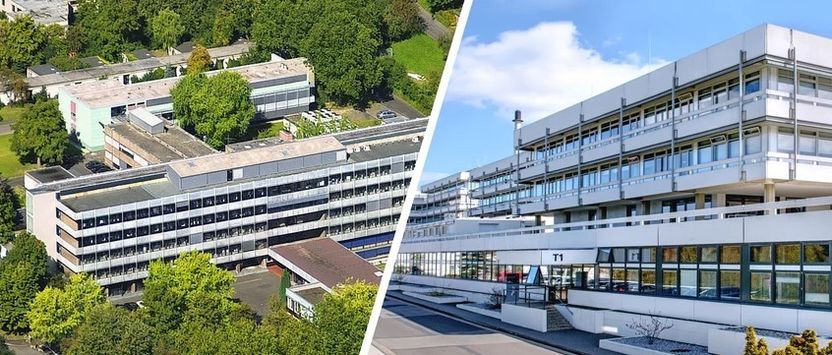Intelligent rubber materials
The vision: materials that respond to active triggers
Wearable medical devices, such as the soft exoskeletons that provide support for stroke patients or controlled drug delivery patches, have to be made of materials that can adapt intelligently and autonomously to the wearer's movements and to changing environmental conditions. These are precisely the type of autonomously switchable polymer materials that have recently been developed by materials scientists at the University of Stuttgart and pharmacists at the University of Tübingen, whose research findings have been reported in Advanced Materials Technologies, a leading specialist journal.

Intelligent rubber material that adapts to ambient humidity. This wristband shows the material's ability to adapt, in this case, to wrist movements.
F. Sterl, Universität Stuttgart, FSM-Labor
The collaborating groups, which are headed up by Prof. Sabine Ludwigs (Institute of Polymer Chemistry) and Prof. Holger Steeb (Institute of Mechanics, MIB) at the University of Stuttgart and Prof. Dominique Lunter (at the University of Tübingen's Department of Pharmaceutical Technology), have published a paper entitled "Autonomous Adaptation of Intelligent Humidity-Programmed Hydrogel Patches", in which they demonstrate how intelligent polymer materials can be produced, whereby the word “intelligent” refers to the fact that the properties of the material can adapt autonomously to the environmental conditions in which they are used. The rigidity of the materials in question can change by more than four orders of magnitude depending on humidity and temperature, and can undergo elastic changes even when subjected to major deformations, which enables the mechanical properties to adjust to the respective application.
Very high degree of adaptability
One of the authors of the paper, Sabine Ludwigs, refers to these materials as "Intelligent Rubber Materials" and explains that: "this high level of adaptability makes our polymers ideally suited for robots made of soft organic materials, such as those used in biomedicine or in search and rescue missions – the keyword here being ‘soft robotics’. These polymers are also very well suited for use in smart skin applications, such as exoskeletons made of soft flexible fabrics." For both applications, the material needs to allow for both fast and slow movements, meaning it needs to have adjustable viscoelastic properties. "That is exactly what the material we have developed is able to do," says Holger Steeb.
In addition, the material's hydro-adaptability and reversible water absorption capacity make it suitable for use as a patch for the controlled release of drugs via the skin. The researchers specifically conducted experiments with the release of the painkiller diclofenac in a skin model. "The key mechanism is that it is the patch itself that controls the release of the active ingredient in response to the variable moisture levels of the wound, i.e., depending on the fluids that seep out of the wound," says Dominique Lunter, a pharmaceutical expert based in Tübingen, Germany.
The relevant research was carried out as part of the recently established cross-faculty Functional Soft Materials Laboratory (FSM Lab) at the University of Stuttgart's Data-integrated Simulation Science Cluster of Excellence (EXC 2075, SimTech). This is the result of a very successful collaboration between two research groups headed up by Sabine Ludwigs who specializes in polymer chemistry, and Holger Steeb, whose work is focused on the mechanics and function of smart polymer materials.
The vision: materials that respond to active triggers
Going forward, the researchers at the University of Stuttgart are planning to investigate multifunctional material systems, which are able to autonomously adapt to their environment as well as react to active triggers, such as electrical stimuli. They are also planning to use simulations as a basis for modeling and predicting complex architectures. As such, the polymer materials research results also benefit the studies being carried out by the university's "Data-Integrated Simulation Science "(SimTech)" cluster of excellence.
Original publication
Original publication
S. Pflumm, Y. Wiedemann, D. Fauser, J. Safaraliyev, D. Lunter, H. Steeb, S. Ludwigs: Autonomous Adaption of Intelligent Humidity-Programmed Hydrogel Patches for Tunable Stiffness and Drug Release, Advanced Materials Technologies, Juli 2023
Organizations
Other news from the department science
These products might interest you

Eclipse by Wyatt Technology
FFF-MALS system for separation and characterization of macromolecules and nanoparticles
The latest and most innovative FFF system designed for highest usability, robustness and data quality

HYPERION II by Bruker
FT-IR and IR laser imaging (QCL) microscope for research and development
Analyze macroscopic samples with microscopic resolution (5 µm) in seconds

Get the chemical industry in your inbox
By submitting this form you agree that LUMITOS AG will send you the newsletter(s) selected above by email. Your data will not be passed on to third parties. Your data will be stored and processed in accordance with our data protection regulations. LUMITOS may contact you by email for the purpose of advertising or market and opinion surveys. You can revoke your consent at any time without giving reasons to LUMITOS AG, Ernst-Augustin-Str. 2, 12489 Berlin, Germany or by e-mail at revoke@lumitos.com with effect for the future. In addition, each email contains a link to unsubscribe from the corresponding newsletter.
Most read news
More news from our other portals
Last viewed contents

The Amazon rainforest -- a cloud factory

Liquid platinum at room temperature - The ‘cool’ catalyst for a sustainable revolution in industrial chemistry
Heavy metals in ceramic glaze can pose a risk to health - BfR recommends lower maximum levels for the migration of lead and cadmium from ceramic objects to foods
Heraeus Group creates independent company for its fiber optics business

New State of Matter: Crystalline and Flowing at the Same Time - Particles with pompom-like structure

Monosodium Glutamate

New Max Planck Institute in Göttingen Combines Natural and Medical Sciences - Largest institute in the Max Planck Society




























































